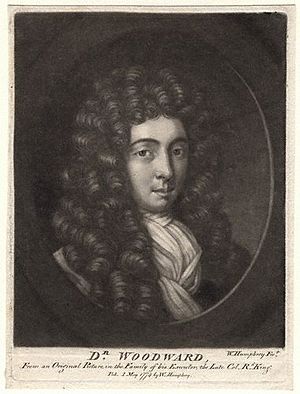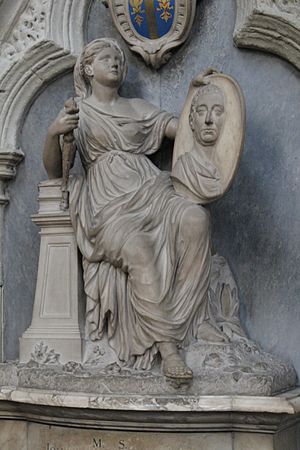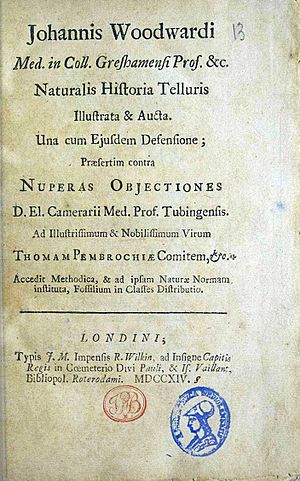John Woodward (naturalist) facts for kids
John Woodward (born May 1, 1665 – died April 25, 1728) was an English scientist who studied nature, old objects, and the Earth. He is famous for setting up the Woodwardian Professorship of Geology at the University of Cambridge through his will. Woodward believed in learning through observation and experiments, which is how modern science works.
Contents
John Woodward's Life Story
John Woodward was born on May 1, 1665, possibly in a village called Wirksworth in Derbyshire, England. When he was 16, he moved to London to become a linen seller. However, he later decided to study medicine with Dr. Peter Barwick, who was a doctor for King Charles II.
Woodward became a very important doctor even though he never went to a university. He was a key figure in a big debate in the early 1700s called the "Quarrel of the Ancients and the Moderns." This was a discussion about whether old ideas or new ideas were better in science and medicine. Woodward strongly supported the "modern" way of thinking, which focused on new discoveries and experiments.
In 1692, Woodward became a professor of medicine at Gresham College. The next year, in 1693, he was chosen to be a member of the Royal Society, a famous group of scientists. In 1695, he earned his medical degree (M.D.) from Archbishop Tenison and Cambridge University. He also became a member of the Royal College of Physicians in 1702.
John Woodward passed away on April 25, 1728. He was buried in Westminster Abbey, a very important church in London. A memorial statue was put up in the Abbey in 1732 to remember him.
John Woodward's Discoveries and Books
In 1699, John Woodward did some interesting experiments with spearmint plants using water. He found that plants grew better in water that was less pure, compared to plants grown in distilled (very pure) water. This was an early step in understanding how plants get nutrients.
While he was still a student, Woodward became very interested in plants and natural history. During visits to Gloucestershire, he noticed many fossils. He started collecting them, and his collection became very famous.
In 1695, he published an important book called An Essay toward a Natural History of the Earth and Terrestrial Bodies, especially Minerals, &c. He later wrote Brief Instructions for making Observations in all Parts of the World (1696) and An Attempt towards a Natural History of the Fossils of England (1728 and 1729).
In these books, Woodward explained that the Earth's rocky surface is made of different layers, called strata. He also correctly believed that the fossils found inside these layers originally came from the sea. However, his ideas about exactly how rocks were formed were not widely accepted. Even though some people made fun of his ideas, Woodward was very good at describing the rocks, minerals, and fossils in his detailed Catalogue.
Woodward also had a long disagreement about smallpox with another doctor, John Freind. Woodward wrote a book about it called The State of Physick and of Diseases... Particularly of the Smallpox (1718). Woodward thought that smallpox was caused by too much of certain "bilious salts" in the body, based on his experiments. Freind, however, believed the causes of the disease could not be known.
Dr. Woodward's Shield
John Woodward owned a special shield that was bought by John Conyers from a London seller. Woodward bought it after Conyers' daughter sold it. Woodward and others thought this shield was a very old Roman shield. However, today we know it was actually a French Renaissance shield from the mid-1500s. It might have even come from the royal collection of King Charles II.
In 1713, Woodward wrote a detailed paper about the shield. This paper led to a funny poem by Alexander Pope, who made fun of people who were too obsessed with old objects.
Woodward's Gift to Cambridge University
In his will, John Woodward asked for his belongings to be sold. The money from the sale was used to buy land worth £150 a year for the University of Cambridge. He wanted a lecturer to be chosen and paid £100 a year to give at least four lectures annually. These lectures were to be about topics from his book, Natural History of the Earth.
This generous gift created the Woodwardian Professorship of Geology, a special teaching position at the university. Woodward also gave his large collection of English fossils to the university. This collection was to be looked after by the geology lecturer. These fossils became the start of the Cambridge Woodwardian Museum, and they are now part of the Sedgwick Museum of Earth Sciences.
John Woodward's Published Works
- Brief Instructions for making Observations in all Parts of the World, 1696
- An Essay toward a Natural History of the Earth and Terrestrial Bodies 1695; 1704; 1714; 3rd ed., 1723; illustrated, inlarged, and defended, 1726
- Remarks upon the antient and present state of London, occasioned by some Roman urns, coins, and other antiquities, lately discovered (3rd ed., 1723)
- An Attempt towards a Natural History of the Fossils of England (2 volumes, 1728 and 1729)




